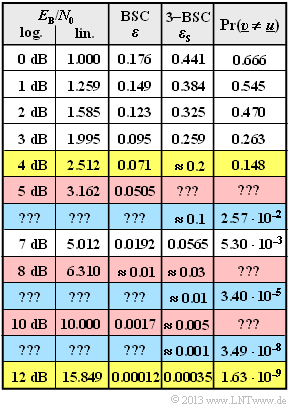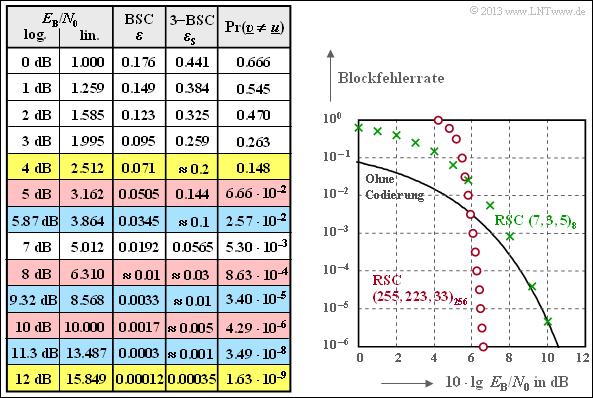Difference between revisions of "Aufgaben:Exercise 2.15: Block Error Probability with AWGN"
| Line 49: | Line 49: | ||
* The exercise belongs to the chapter [[Channel_Coding/Error_Probability_and_Areas_of_Application| "Error Probability and Application Areas"]]. | * The exercise belongs to the chapter [[Channel_Coding/Error_Probability_and_Areas_of_Application| "Error Probability and Application Areas"]]. | ||
| − | * We refer you here to the two interactive applets | + | * We refer you here to the two interactive HTML5/JavaScript applets |
:*[[Applets:Complementary_Gaussian_Error_Functions|"Complementary Gaussian error functions"]], and | :*[[Applets:Complementary_Gaussian_Error_Functions|"Complementary Gaussian error functions"]], and | ||
Revision as of 16:22, 1 November 2022
Using the example of $\rm RSC \, (7, \, 3, \, 5)_8$ with parameters
- $n = 7$ $($number of code symbols$)$,
- $k =3$ $($number of information symbols$)$,
- $t = 2$ $($correction capability$)$.
the calculation of the block error probability in "Bounded Distance Decoding" $\rm (BDD)$ shall be shown. The corresponding equation is:
- $${\rm Pr(block\:error)} = {\rm Pr}(\underline{v} \ne \underline{u}) = \sum_{f = t + 1}^{n} {n \choose f} \cdot {\varepsilon_{\rm S}}^f \cdot (1 - \varepsilon_{\rm S})^{n-f} \hspace{0.05cm}.$$
⇒ The calculation is performed for the "AWGN channel" characterized by the parameter $E_{\rm B}/N_0$:
- The quotient $E_{\rm B}/{N_0}$ can be expressed by the relation
- $$\varepsilon = {\rm Q} \big (\sqrt{{2 \cdot R \cdot E_{\rm B}}/{N_0}} \big ) $$
- into the "BSC model" where $R$ denotes the code rate $($here: $R = 3/7)$ and ${\rm Q}(x)$ indicates the "complementary Gaussian error integral".
- But since in the considered code the symbols come from $\rm GF(2^3)$, the BSC model with parameter $\varepsilon$ must also still be adapted to the task.
- For the falsification probability of the "m– BSC" model applies:
- $$\varepsilon_{\rm S} = 1 - (1 - \varepsilon)^m \hspace{0.05cm}.$$
- Here it is to be set $m = 3$ $($three bits per code symbol$)$.
⇒ For some $E_{\rm B}/N_0$ values the results are entered in the table above. The two rows with yellow background are briefly explained here:
- For $10 \cdot \lg {E_{\rm B}/N_0} = 4 \ \rm dB$ we get $\varepsilon \approx {\rm Q}(1.47) \approx 0.071$ and $\varepsilon_{\rm S} \approx 0.2$. The block error probability here can most easily be calculated using the complement:
- $${\rm Pr(block\:error)} = 1 - \left [ {7 \choose 0} \cdot 0.8^7 + {7 \choose 1} \cdot 0.2 \cdot 0.8^6 + {7 \choose 2} \cdot 0.2^2 \cdot 0.8^5\right ] \approx 0.148 \hspace{0.05cm}.$$
- For $10 \cdot \lg {E_{\rm B}/N_0} = 12 \ \rm dB$ one gets $\varepsilon \approx 1.2 \cdot 10^{-4}$ and $\varepsilon_{\rm S} \approx 3.5 \cdot 10^{-4}$. With this very small falsification probability, the $f = 3$ term dominates, and we obtain:
- $${\rm Pr(block\:error)} \approx {7 \choose 3} \cdot (3.5 \cdot 10^{-4})^3 \cdot (1- 3.5 \cdot 10^{-4})^4 \approx 1.63 \cdot 10^{-9} \hspace{0.05cm}.$$
⇒ You are to calculate the block error probabilities for the rows highlighted in red $(10 \cdot \lg {E_{\rm B}/N_0} = 5 \ \rm dB, \ 8 \rm dB$, $10 \ \rm dB)$.
- The rows with blue background show some results of "Exercise 2.15Z". There ${\rm Pr}(\underline{v} ≠ \underline{u})$ is calculated for $\varepsilon_{\rm S} = 10\%, \ 1\%$ $0.1\%$.
- In subtasks (4) and (5) you are to establish the relationship between the quantity $\varepsilon_{\rm S}$ and the AWGN parameter $E_{\rm B}/N_0$ thus completing the above table.
Hints:
- The exercise belongs to the chapter "Error Probability and Application Areas".
- We refer you here to the two interactive HTML5/JavaScript applets
Questions
Solution
- This gives $\varepsilon_{\rm S}$ for the symbol corruption probability with $m = 3$:
- $$1 - \varepsilon_{\rm S} = (1 - 0.0505)^3 \approx 0.856 \hspace{0.3cm}\Rightarrow \hspace{0.3cm} \varepsilon_{\rm S} \approx 0.144 \hspace{0.05cm}.$$
- The fastest way to calculate the block error probability here is to use the formula
- $${\rm Pr(Block\:error)} \hspace{-0.15cm} \ = \ \hspace{-0.15cm} 1 - {\rm Pr}(f=0) - {\rm Pr}(f=1) - {\rm Pr}(f=2) = 1 - 1 \cdot 0.856^7 - 7 \cdot 0.144^1 \cdot 0.856^6 - 21 \cdot 0.144^2 \cdot 0.856^5$$
- $$\Rightarrow \hspace{0.3cm} {\rm Pr(Block\:error)} \hspace{-0.15cm} \ = \ \hspace{-0.15cm} {\rm Pr}(\underline{v} \ne \underline{u}) =1 - 0.3368 - 0.3965 - 0.2001 \hspace{0.15cm} \underline{=0.0666} \hspace{0.05cm}.$$
(2) Following the same calculation procedure as in subtask (1), the following is obtained with $\varepsilon_{\rm S} \approx 0.03 \ \Rightarrow \ 1 - \varepsilon_{\rm S} = 0.97$:
- $${\rm Pr(Block\:error)} \hspace{-0.15cm} \ = \ \hspace{-0.15cm} 1 \hspace{-0.05cm}-\hspace{-0.05cm} 1 \cdot 0.97^7 \hspace{-0.05cm}-\hspace{-0.05cm} 7 \cdot 0.03^1 \cdot 0.97^6 \hspace{-0.05cm}-\hspace{-0.05cm} 21 \cdot 0.03^2 \cdot 0.97^5 =1 \hspace{-0.05cm}-\hspace{-0.05cm} 0.8080 \hspace{-0.05cm}-\hspace{-0.05cm} 0.1749\hspace{-0.05cm}-\hspace{-0.05cm} 0.0162= 1 \hspace{-0.05cm}-\hspace{-0.05cm} 0.9991 = 9 \cdot 10^{-4} \hspace{0.05cm}.$$
- You can see that here the difference between two numbers of almost the same size must be formed, so that the result could be affected by an error.
- Therefore we still calculate the following quantities:
- $${\rm Pr}(f=3) \hspace{-0.15cm} \ = \ \hspace{-0.15cm} {7 \choose 3} \cdot \varepsilon_{\rm S}^3 \cdot (1 - \varepsilon_{\rm S})^4 = 35 \cdot 0.03^3 \cdot 0.97^4 = 8.366 \cdot 10^{-4}\hspace{0.05cm},$$
- $${\rm Pr}(f=4) \hspace{-0.15cm} \ = \ \hspace{-0.15cm} {7 \choose 4} \cdot \varepsilon_{\rm S}^4 \cdot (1 - \varepsilon_{\rm S})^3 = 35 \cdot 0.03^4 \cdot 0.97^3 = 0.259 \cdot 10^{-4}\hspace{0.05cm},$$
- $${\rm Pr}(f=5) \hspace{-0.15cm} \ = \ \hspace{-0.15cm} {7 \choose 5} \cdot \varepsilon_{\rm S}^5 \cdot (1 - \varepsilon_{\rm S})^2 = 21 \cdot 0.03^5 \cdot 0.97^2 = 0.005 \cdot 10^{-4}$$
- $$\Rightarrow \hspace{0.3cm} {\rm Pr(Blockfehler)} = {\rm Pr}(\underline{v} \ne \underline{u}) \approx {\rm Pr}(f=3) + {\rm Pr}(f=4) + {\rm Pr}(f=5) \hspace{0.15cm} \underline{=8.63 \cdot 10^{-4}} \hspace{0.05cm}.$$
- The terms for $f = 6$ and $f = 7$ can be omitted here. They do not provide a relevant contribution.
(3) Here $\varepsilon_{\rm S} = 0.005 \ \Rightarrow \ 1 - \varepsilon_{\rm S} = 0.995$ is already given in the table.
- The (by far) dominant term in the calculation of the block error probability is ${\rm Pr}(f = 3)$:.
- $${\rm Pr(Blockfehler)} = {\rm Pr}(\underline{v} \ne \underline{u}) \approx {\rm Pr}(f=3) = {7 \choose 3} \cdot 0.005^3 \cdot 0.995^4 \hspace{0.15cm} \underline{\approx 4.3 \cdot 10^{-6}} \hspace{0.05cm}.$$
(4) For the BSC parameter $\varepsilon$ holds with $\varepsilon_{\rm S} = 0.1$:
- $$\varepsilon = 1 -(1 - \varepsilon_{\rm S})^{1/3} = 1 - 0.9^{1/3} \approx 0.0345 \hspace{0.05cm}.$$
- The relation between $\varepsilon$ and $E_{\rm B}/N_0$ is:
- $$\varepsilon = {\rm Q}(x)\hspace{0.05cm}, \hspace{0.5cm} x = \sqrt{2 \cdot R \cdot E_{\rm B}/N_0}\hspace{0.05cm}.$$
- The inverse $x = {\rm Q}^{-1}(0.0345)$ is obtained with the applet "Complementary Gaussian Error Functions" to $x = 1.82$.
- This further gives:
- $$E_{\rm B}/N_0 = \frac{x^2}{2R} = \frac{1.82^2}{2R \cdot 3/7} \approx 3.864 \hspace{0.3cm} \Rightarrow \hspace{0.3cm} 10 \cdot {\rm lg}\hspace{0.15cm}(E_{\rm B}/N_0) \hspace{0.15cm} \underline{\approx 5.87 \,\, {\rm dB}} \hspace{0.05cm}. $$
(5) After the same calculation one obtains
- für $\varepsilon_{\rm S} = 10^{-2} \ \Rightarrow \ \varepsilon \approx 0.33 \cdot 10^{-2} \ \Rightarrow \ x = {\rm Q}^{-1}(\varepsilon) = 2.71$
- $$E_{\rm B}/N_0 = \frac{x^2}{2R} = \frac{2.71^2}{2R \cdot 3/7} \approx 8.568 \hspace{0.3cm} \Rightarrow \hspace{0.3cm} 10 \cdot {\rm lg}\hspace{0.15cm}(E_{\rm B}/N_0) \hspace{0.15cm} \underline{\approx 9.32 \,\, {\rm dB}} \hspace{0.05cm}, $$
- for $\varepsilon_{\rm S} = 10^{-3} \ \Rightarrow \ \varepsilon \approx 0.33 \cdot 10^{-3} \ \Rightarrow \ x = {\rm Q}^{-1}(\varepsilon) = 3.4$:
- $$E_{\rm B}/N_0 = \frac{x^2}{2R} = \frac{3.4^2}{2R \cdot 3/7} \approx 13.487 \hspace{0.3cm} \Rightarrow \hspace{0.3cm} 10 \cdot {\rm lg}\hspace{0.15cm}(E_{\rm B}/N_0) \hspace{0.15cm} \underline{\approx 11.3 \,\, {\rm dB}} \hspace{0.05cm}. $$
The graph shows the course of the block error probability as a function of $10 \cdot \lg {E_{\rm B}/N_0}$ as well as the completely filled result table.
One can see the clearly less favorable (asymptotic) behavior of this short (green) code $\rm RSC \, (7, \, 5, \, 3)_8$ compared to the (red) comparison code $\rm RSC \, (255, \, 223, \, 33)_8$:
- For abscissa values smaller than $10 \ \rm dB$ the result is even worse than without coding.
- Therefore it should be pointed out again that this $\rm RSC \, (7, \, 3, \, 5)_8$ has little practical meaning.
- It was chosen for this exercise only to be able to demonstrate with reasonable effort the calculation of the block error probability for "Bounded Distance Decoding" (BDD).

